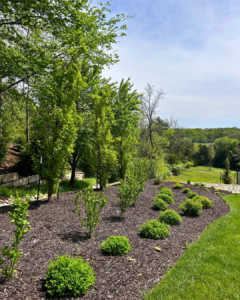Your landscape may go dormant in the winter, but it doesn’t die completely. The steps you take now will affect how well your lawn and garden survive the bitter cold. Here are the steps you should take to ensure your landscape bounces back next spring.
Preparing Your Landscape for Winter
- Aerate your lawn in the fall to break up dry, compacted soil. This gives the roots easy access to water, oxygen, and nutrients—just what it needs to help it through the cold, harsh winter.
- Overseed your grass in the fall to help fill in bare spots and make the lawn less vulnerable to disease. This simple measure ensures a thick, green lawn come spring.
- Fertilize in mid to late fall to make your turf nutrient-rich going into the cold season. The resulting root growth will give your lawn a head start next spring when the weather warms up.
- Apply herbicide in the fall to control perennial weeds like thistles and dandelions more effectively than spraying in the summer.
- Plant for spring on a mild fall day. By now, the heat of summer is over, so insects and diseases have less chance of harming young, vulnerable trees and shrubs. Bulbs should also be in the ground by mid-October before winter’s chill arrives.
- Tidy up once the growing season is over to rid your property of dead foliage. Remove annuals completely and cut back the stems of perennials to within an inch or two of the ground. Removing plant debris from your garden reduces the risk of disease and pest problems throughout the winter.
- Winterize your sprinklers before the first freeze to help prevent costly damage to your water lines. It’s best to leave this task to a professional landscaping company.
- Keep watering your trees and shrubs even after the irrigation system is turned off. Provide a deep watering every three to four weeks throughout the fall and winter, as long as the temperature is above freezing.
- Lay mulch in your flowerbeds and around young shrubs and trees to protect them from hard freezes. Mulch insulates the soil to help plant roots stay warmer and retain moisture more effectively. For the best results, apply mulch in a donut shape around plants, leaving room at the base of the stem or trunk.
- Prune trees and shrubs once winter arrives. It’s important to wait until plants are fully dormant before pruning them to avoid stimulating new growth.
FAQs About Winter Landscaping
What happens if you neglect your lawn all winter?
You could be left with yellow, patchy, weed-ridden grass come spring if you don’t take care of it properly during the colder months. Coaxing neglected grass to bounce back could be costly and time-consuming, which you can avoid by maintaining your lawn in the fall and winter.
Do I have to rake my leaves?
This chore is important for several reasons. It keeps you compliant with local ordinances, prevents suffocating your grass, and avoids other leaf-related problems such as clogged storm drains and stained decks.
Are there any plants I shouldn’t prune in the winter?
Yes. Certain spring bloomers should be pruned in the spring after their flowers fade, including lilacs, redbuds, forsythia, and crabapples. However, there are exceptions to this pruning rule. When in doubt, speak to a landscaping expert.
Schedule Fall and Winter Yard Maintenance
Lawrence Landscape can keep your yard looking great with onsite visits this fall and winter. Let us tackle any task you feel unsure about or don’t have the time to perform yourself. With decades of landscaping experience and NALP certification to back us up, you can trust our team to take great care of your lawn and plants.
Contact us today at (785) 843-4370 to schedule fall or winter landscape services in the Lawrence, KS area.




